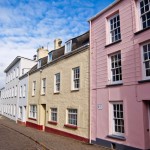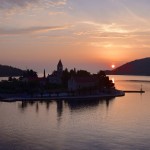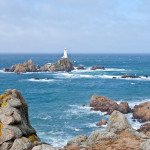On his sustainable trip to Guernsey, Rupert Parker discovers exploring by bike and on foot is an eco-friendly way to discover this Channel Island.
Last year I made a sustainable visit to Jersey, in the Channel Islands, travelling by train and ferry and getting around on an e-bike. I was so impressed that I decide to do this again, this time to its smaller sister Guernsey. Again I take the train to Poole and board the Condor Ferry which arrives in St Peter Port in around three hours.
I’ve worked out that it I hire an e-bike it will be an easy adventure for my level of cycling. The Northern part of the island is completely flat with its wide bays home to vast sandy beaches. The only obstacle is the wind, but like most things in Guernsey, it’s fairly benign.
The South, however, is all rugged cliffs with steep descents into small bays and wooded coves. Of course going down means a tough following climb upwards, often to stunning viewpoints. Peppered around the coast are small kiosks and tea rooms providing welcome refreshment. You can do the whole island in a day but better to take it leisurely and split it into two.
St Peter Port to Lihou Island

I start my coastal adventure by heading south from St. Peter Port towards the cliffs of Jerbourg Point. There are no cycle paths and the only option is to take the main road. However traffic is light and drivers tend to tuck in behind until there’s a safe opportunity for overtaking.
After I pass the Doyle monument, I’m soon at the headland overlooking Jerbourg Point. Jagged cliffs drop down to the sea and the rocks end in a series of stacks. From here, I take narrow lanes westwards, helpfully labelled Ruettes Tranquilles, which take me through attractive wooded glades.
I park my bike and walk to Moulin Huet Bay, a favourite spot of the French painter Renoir. The bay’s clear waters and dramatic rock formations inspired many of his works. There follows a succession of tiny rocky beaches, including Saints Bay and Petit Bot with its tower.

All require further ups and downs but I’m soon at Torteval, on the South Western Tip. The headland is honeycombed with German fortifications from WW2 including the imposing Pleinmont Observation Tower. As I turn the corner, the landscape becomes gentler opening out to long wide bays.
Fort Grey, on Rocquaine Bay, an 18th century fort, now houses a shipwreck museum, detailing disasters on the surrounding seas. As I cycle north I stop by at Lihou Island, a nature reserve only accessible by causeway at low tide. Here I turn inland, cycling due east through Castel back to St Peter Port. This is agricultural heaven, blessed by traditional farmhouses, and fields dotted with grazing Guernsey cows.
North to Vazon Bay

Next day I head north, along the sea front of St Peter Port, to the working harbour at St Sampson. The coast leads me to little Fort Doyle perched on a rocky headland. Further on, at the northernmost tip, another fortification, Fort Le Marcand is slightly more substantial. It overlooks the long stretch of beach, known as Pembroke Bay, with its WW2 German fortified seawall.
The track turns into a footpath so I turn inland crossing the Royal Guernsey Golf Course before arriving at Le Grande Havre. The wide beach is guarded by the loopholed Rousse Tower, one of a series of 15 built at the end of the 18th century, to repel the French. I battle the prevailing wind as I cross Cobo Bay before turning inland at Vazon Bay. It’s then a cross country ride back to St Peter Port.
Hiking St Peter Port to Fermain Bay.

For my final day, I fancy getting off my bike and exploring on foot – one of most popular walks on Guernsey runs from St Peter Port to Fermain Bay. It’s a gentle wooded path, lined with spring flowers, with flights of steps, taking me up and down. Soon Fermain Bay comes into view, an attractive spot with a loopholed tower and boats moored in the bay.
It’s only taken me an hour so I decide to press on to Jerbourg Point. There are good views of the Pea Stacks and German fortifications on the headland. I follow the path along the clifftop to Petit Port and take hundreds of steps down to the bay. Climbing up again, I’m soon at Moulin Huet Bay and then turn back inland.


From here, it’s mainly road walking back to Sausmarez Manor, above Fermain Bay and onwards to St Peter Port. The last stretch turns off on a grassy path following the curtain wall of Fort George before descending to the South Esplanade and the capital.
The good folks at the hire company have been kind enough to pick up my e-bike from the hotel, so I make my way to the Condor ferry terminal, homeward bound. This is definitely a no-stress way to travel and it’s also a good way to get into shape. Even better, I feel I’ve done my tiny bit to save the planet.
Tell Me More About this Sustainable Trip To Guernsey.
Visit Guernsey has more about this Sustainable Trip To Guernsey and other tourist information.
Cicerone’s Walking on Guernsey is an excellent guide.
Condor Ferries sail daily to Guernsey from Poole in 3 hours for £56 each way for foot passengers. They also offer a 3 night B&B package at the Peninsula Hotel for £525.60 in September or £345.40 in October, based on single occupancy including return ferry fare.
Go Guernsey Land & Sea supplies e-bikes.
La Fregate is an exclusive boutique hotel in St Peter Port with an excellent restaurant.
The Peninsula Hotel sits on Le Grande Havre Bay, on the other side of the island, and has great sea views.
Puffin & Oyster is close to the Peninsula Hotel and offers grills and seafood.
Balthazar is in St Peter Port and is good for fish.
The Brasserie in the Old Government House Hotel has fine dining.






